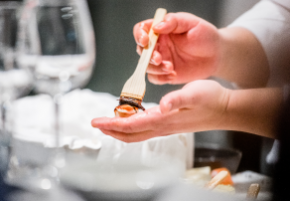- About
- Programs
- Campus Life
- Career Services
- Admissions
- News & Events
- Alumni
How to Make a Roux: Types, Uses and Recipes
Learn how to make a roux for perfect sauces and gravies. Discover types, ratios, and tips—then try it in your next recipe!
Key Takeaways
- There are three main types of roux, each differing in color, flavor, and cooking time.
- The longer a roux cooks, the darker it becomes. The color affects not just the taste but also how much thickening power the roux retains.
- Roux can be made ahead, stored in the fridge or freezer, and added directly to recipes for quick, flavorful results.
- Always cook roux over medium or medium-low heat and stir continuously to keep it from sticking or scorching.
If you've ever wondered why your favorite gravy, gumbo, or cheese sauce tastes so rich and smooth, chances are, it all starts with a roux. A roux (pronounced "roo") is a simple mix of fat and flour, cooked together to create a thickening and flavor-boosting base for soups, stews, and sauces.
It's one of those kitchen basics that seems fancy but is surprisingly easy to master. Learning how to make a roux can add richer flavor and a creamy touch to your everyday cooking.
Types of Roux
One way to differentiate the types of roux is by their color: white roux is pale, blond roux is golden, and brown roux is dark and rich. The main factor behind these differences is cooking time—the longer a roux cooks, the darker it becomes. This change in color also affects flavor and thickening power: lighter roux thickens more effectively, while darker roux adds deeper, nuttier flavors but with less thickening strength.
To make a basic roux, you only need two ingredients: flour and fat. All-purpose flour is the standard, but you can use gluten-free or whole-wheat alternatives if needed. The typical ratio is 1:1 by weight, though you can adjust slightly depending on how thick you want your final dish.
Tools you'll need to make roux include:
- Heavy-bottomed pan or skillet (non-stick or cast iron recommended)
- Whisk or wooden spoon (for continuous stirring)
- Measuring scale or cups
- Heat-resistant spatula (optional, but handy for scraping edges)
White roux
White roux is the lightest of all roux types. It has a pale or slightly off-white color and is cooked just long enough to eliminate the raw taste of flour without allowing any browning.
Because it is cooked briefly, it does not develop much flavor but offers the highest thickening power. That makes it ideal for delicate, creamy dishes where you want a smooth texture without altering the taste too much. It is commonly used in béchamel sauce, cheese sauce, and creamy soups like chowders or potato leek.
How to make a white roux
To make white roux:
- Start by heating your fat (typically butter) in a heavy-bottomed skillet over medium heat.
- Once melted, stir in an equal amount of all-purpose flour by weight.
- Stir constantly using a whisk or wooden spoon.
- Cook gently for 2 to 5 minutes. The roux should bubble, thicken to a paste-like consistency, and remain pale in color.
- Do not let it darken. The key is low heat and constant attention to preserve its light color.
Start Your Culinary Journey
Learn the art of cooking in a world-class environment
Blonde roux
Blonde roux is cooked slightly longer than white roux, developing a warm golden color and a mild nutty aroma. It offers a nice balance between flavor and thickening power. While it does not thicken as strongly as white roux, it adds more depth to the dish without overpowering other ingredients.
Blonde roux is commonly used in velouté sauces, cream soups, and light gravies. Its smooth texture and subtle taste make it a go-to base for dishes that need a bit of richness without the heaviness of a darker roux.
How to make a blonde roux
To make blonde roux:
- Begin the same way you would with a white roux by melting butter in a heavy skillet over medium heat.
- Add an equal amount of flour and stir constantly.
- Cook the mixture for 5 to 10 minutes. You are aiming for a light tan color and a toasty, nutty smell. The texture should remain smooth and bubbling.
- Watch the color closely while stirring. Roux can go from blonde to brown faster than you expect, and even a slight overcook will shift the flavor and color.
Brown roux
Brown roux is the darkest and most flavorful version of roux, cooked until it reaches a deep brown, almost chocolate-like color. It brings a bold, nutty, and complex taste that defines many Southern and Creole dishes.
Because it cooks for a long time, it loses much of its thickening ability but makes up for it with rich, layered flavor. Brown roux is a staple in dishes like gumbo, étouffée, and other Cajun or Creole recipes where depth and color matter more than thickness.
How to make a brown roux
Making brown roux takes time and attention. To make brown roux:
- Use a heavy skillet and heat oil over medium-low heat. Oil is preferred over butter because it can handle longer cooking without burning.
- Add an equal amount of flour and stir constantly for 15 to 30 minutes.
- Watch for a deep brown color and a rich, roasted aroma. The texture should stay smooth the entire time.
- Be patient. If you stop stirring or rush the heat, the roux can burn quickly and will need to be started over. Slow and steady wins the flavor.
Popular Recipes That Use Roux
Roux is one of the most versatile bases in cooking, quietly working behind the scenes to give body, texture, and depth to many dishes. From French classics to Southern comfort food, roux serves as the foundation for recipes across different cuisines. Depending on how long it's cooked, roux can support everything from delicate, creamy sauces to rich, hearty stews.
Here are a few popular recipes that use roux:
- Béchamel sauce: A white sauce made with white roux and milk. It is one of the five French "mother sauces" and forms the base for dishes like lasagna, soufflés, and creamy gratins.
- Gumbo: A flavorful Louisiana stew made with dark brown roux, vegetables, and either seafood or meat. The roux gives it its signature thickness and deep, smoky flavor.
- Macaroni and cheese: Starts with a white roux that becomes the base for a rich cheese sauce. This classic comfort food is smooth, creamy, and always a crowd-pleaser.
- Etouffée: A Cajun or Creole dish that uses a medium to dark roux. It is typically made with shellfish, like crawfish or shrimp, and served over rice with a deeply savory sauce.
How to Store Roux
Roux can be stored in the refrigerator for short-term use or frozen for longer storage. Here's how to keep it fresh and ready when you need it:
Refrigerating roux
Storing roux in the refrigerator is a great option if you plan to use it within the next few weeks. Once it has cooled to room temperature, follow these steps:
- Use the right container: Choose a glass jar with a tight-fitting lid or a BPA-free plastic container. Avoid using metal containers, as they can react with the roux and affect its taste.
- Label and date: Always label the container with the date you made the roux. This helps you keep track of freshness.
- Store properly: Place the container on a middle or lower fridge shelf where the temperature is more stable.
Roux stored in the fridge will last up to 2 to 4 weeks. Before using, let it soften at room temperature for easier stirring, then reheat gently in a pan. It's perfect for quick recipes like:
- Cheese sauces
- Creamy soups
- Weeknight gravies or pan sauces
Freezing roux
For long-term storage, freezing roux is a smart way to save time in future cooking. All types—white, blond, or brown roux—can be frozen for up to 6 months.
- Portion it for convenience: Pour warm (not hot) roux into silicone ice cube trays, small silicone molds, or even mini muffin tins.
- Freeze solid: Place the tray in the freezer until the roux is completely frozen, which usually takes a few hours.
- Transfer and label: Pop the roux cubes out and store them in a freezer-safe bag or airtight container. Label with the roux type and date.
When you're ready to use frozen roux, simply drop a cube directly into a hot soup, stew, or sauce and whisk until it melts and blends in smoothly. It's an easy way to jumpstart dishes like gumbo, mac and cheese, or creamy pasta sauces.
Frozen roux is especially helpful for large-batch cooking or meal prep. You'll always have a flavorful base ready to go.
Common Mistakes to Avoid When Making Roux
Making roux is simple, but a few missteps can throw off the texture, flavor, or consistency of your entire dish. Here are some of the most common mistakes and how to avoid them:
Burning the roux
Roux requires constant attention. Burning usually happens when the heat is too high, or you stop stirring, even for a moment. Once a roux burns, it takes on a bitter, unpleasant taste and can't be saved. You'll need to start over.
So, always cook it over medium or medium-low heat and stir continuously to keep it from sticking or scorching.
Adding liquid too soon
It's tempting to speed things up, but adding liquid before the roux has cooked enough results in a raw, chalky flavor that lingers in your dish.
Let the mixture cook until it reaches the desired color and gives off a slightly nutty or toasty aroma, depending on the type of roux you're making.
Using the wrong fat or flour
Butter and all-purpose flour are the go-to combination but are not the only option. If you're using oil instead of butter when making a roux, pick one with a high smoke point, like vegetable, canola, or avocado oil, especially for darker roux that requires longer cooking. For gluten-free alternatives, avoid single flours like almond or coconut, which can create grainy or uneven textures.
Master Stirring the Roux
From creamy white sauces to bold, flavorful gumbos, roux is a foundational technique every aspiring chef should know. Roux is more than just flour and fat; it is the base of countless classic recipes across cultures. By understanding the different types of roux, how to cook them properly, and how to store them for future use, you gain a versatile skill that can advance your cooking to a new level.
To master techniques like this and build a strong culinary foundation, the Culinary Arts BA program at Culinary Arts Academy Switzerland (CAAS) is the perfect place to start. Learn from experienced chefs, explore global cuisines, and gain the hands-on experience needed to turn your passion for food into a professional future.
Frequently Asked Questions (FAQs)
Can I make a roux without butter?
Yes, you can. Oils like vegetable, canola, or olive oil work well as substitutes for butter, especially for darker roux that require longer cooking times.
Can I make half a roux?
Absolutely, just use half the amount of flour and fat, keeping the same 1:1 ratio by weight.
How to fix a broken roux?
If your roux looks lumpy or separated, try whisking it vigorously over low heat or add a little more fat to smooth it out.
Interested in studying at CAAS? Download our brochure to learn about our programs!
























